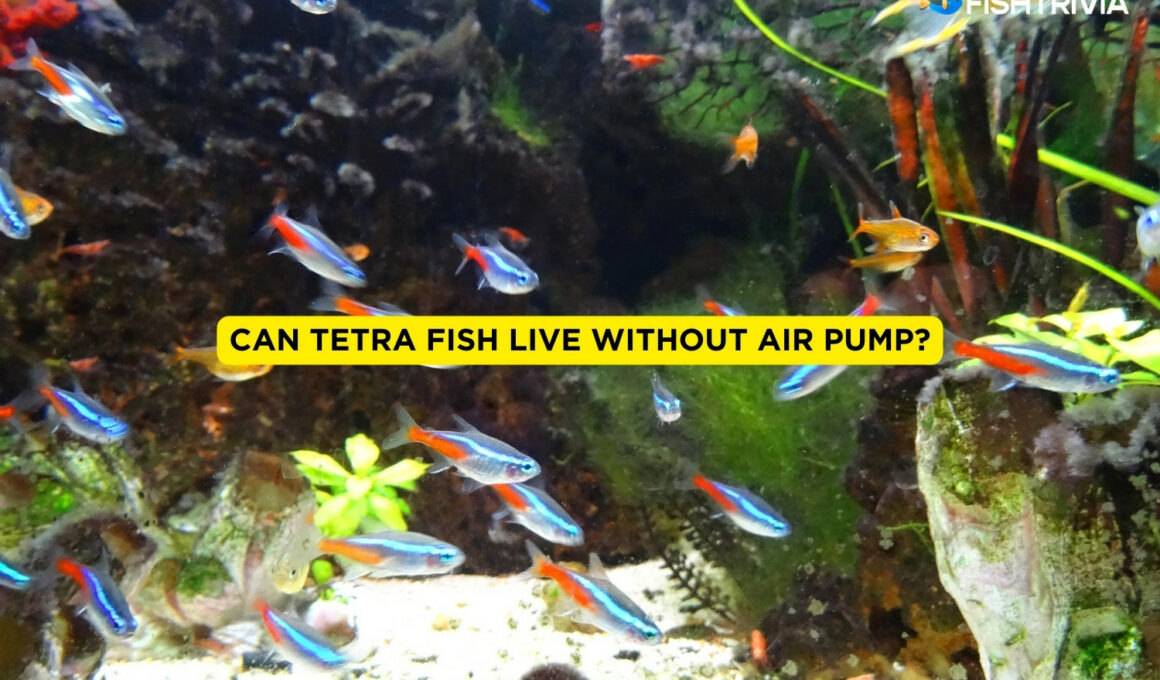In this article Show
Today, we’re addressing a crucial question that often surfaces among fish keepers: Can tetra live without an air pump? Understanding this aspect is vital for ensuring the health and well-being of these vibrant fish in your aquarium.
As an experienced fish keeper, I’ll share insights grounded in knowledge and practice, aiming to make the information clear, direct, and beneficial for both beginners and seasoned hobbyists alike.
Can Tetras Live Without Air Pump?
Yes, tetrafish can survive without an air pump, but with certain conditions. In a well-maintained aquarium, tetras can thrive as long as there is sufficient oxygenation of the water, which can be achieved through alternative methods like live plants or proper tank circulation. However, for optimal health and vibrancy of tetra fish, especially in smaller or densely stocked tanks, an air pump is recommended to ensure a stable and oxygen-rich environment. This balance is key to maintaining a healthy ecosystem for your tetras.
Also worth reading;
- Guppies and Neon Tetras – Can You Keep Them Together?
- Neon Tetra vs. Cardinal Tetra: What Is the Difference?
- Neon Tetra Disease: A Complete Guide

Signs of Oxygen Deprivation in Tetra Fish
Identifying oxygen deprivation in tetra fish is crucial for maintaining their health and well-being. Here’s how you can recognize if your tetras are not getting enough oxygen and the immediate steps you should take:
Behavioral Changes
The first sign of oxygen deprivation is often a change in behavior. Tetras may become less active, swim less, or spend more time at the water’s surface gasping for air. They might also show less interest in food or display erratic swimming patterns.
Physical Symptoms
Look for physical signs such as rapid gill movement. When tetras struggle for oxygen, their gills work harder and faster to extract oxygen from the water. Additionally, their color might become duller, indicating stress and poor health.
Immediate Steps
If you notice these symptoms, act quickly. Start by checking and adjusting your aquarium’s water temperature, as warmer water holds less oxygen. Increase water movement or surface agitation to enhance oxygen exchange.
You can do this by adjusting the filter output or adding an air stone temporarily. It’s also important to test water quality, as high levels of ammonia and nitrites can reduce oxygen availability. If necessary, perform a partial water change to improve conditions.
Regular monitoring of your aquarium’s environment, including water quality and temperature, will help in maintaining adequate oxygen levels and prevent issues before they arise.

Best Practices for Tetra Fish Care
Caring for tetra fish involves a combination of proper water conditions, a balanced diet, and a well-maintained environment. Follow these best practices to ensure the optimal health and happiness of your tetras:
1. Water Parameters
Keeping the water parameters within the ideal range is crucial. Tetras thrive in slightly acidic to neutral water (pH 6.0-7.5) with a temperature range of 72-80°F (22-27°C). Regularly test the water for ammonia, nitrites, nitrates, and pH levels to maintain a stable environment. Soft to moderately hard water is preferred for most tetra species.
2. Diet and Feeding
Provide a balanced diet that includes high-quality flake food, supplemented with live or frozen foods like brine shrimp or bloodworms. Feeding small amounts two to three times a day is ideal. Avoid overfeeding, as excess food can decay and deteriorate water quality.
3. Aquarium Setup and Environment
Tetras are schooling fish and thrive in groups, so keep them in a school of at least five to six individuals. A planted aquarium with hiding places and open swimming areas mimics their natural habitat and helps reduce stress. Keep the lighting subdued, as tetras prefer dimmer conditions.
4. Regular Maintenance
Perform regular maintenance to keep the aquarium in top condition. This includes weekly water changes of about 10-20% of the tank volume, cleaning the substrate, and ensuring the filter is functioning correctly. Monitoring equipment like heaters and filters for proper operation is also essential.
5. Observation and Care
Regularly observe your tetras for any signs of stress or disease. Early detection and treatment can prevent more serious health issues. Pay attention to their behavior, appearance, and eating habits for any changes.
By adhering to these care practices, you create a nurturing environment that supports the health and well-being of your tetra fish. A consistent care routine is the key to a vibrant and lively aquarium.










